THE LANDSCAPING SOLUTIONS BLOG
Welcome to our Blog. Inspiration, updates and industry trends from the team at Landscaping Solutions.
THE SUSTAINABLE AESTHETIC
In late 2019 we collaborated with Jilayne Rickards on a small urban garden she designed for a great client in North London. Jilayne christened the scheme ‘The Urban Retreat’.
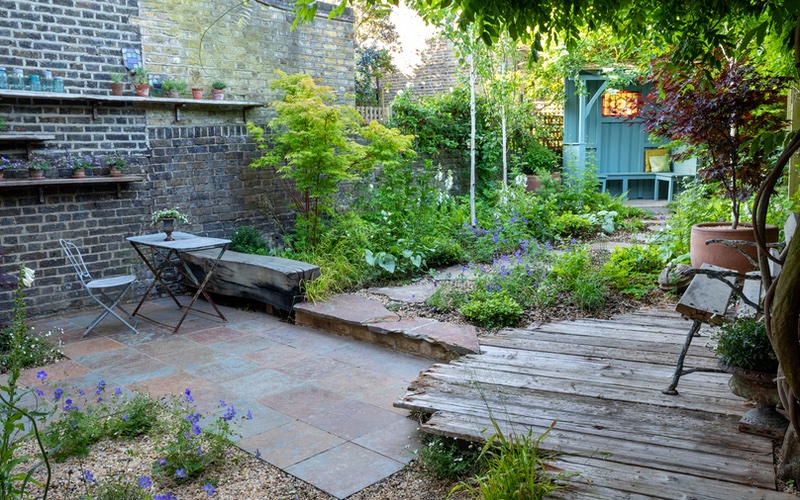
The Urban Retreat in North London, designed by Jilayne Rickards and built by Landscaping Solutions.
Jilayne’s vision was for the garden to be both beautiful and sustainable. In December last year we discovered the garden had picked up four British Association of Landscape Industries awards. The most satisfying of these for us was the award for best use of recycled and reclaimed materials. The recognition this garden received from BALI and the interest and acclaim it has garnered from the wider public offers hope for what we call ‘The sustainable aesthetic’. The more media coverage gardens of this type obtain the more they will come to be considered desirable by the general public and the more likely their guiding ethos will become mainstream thought.
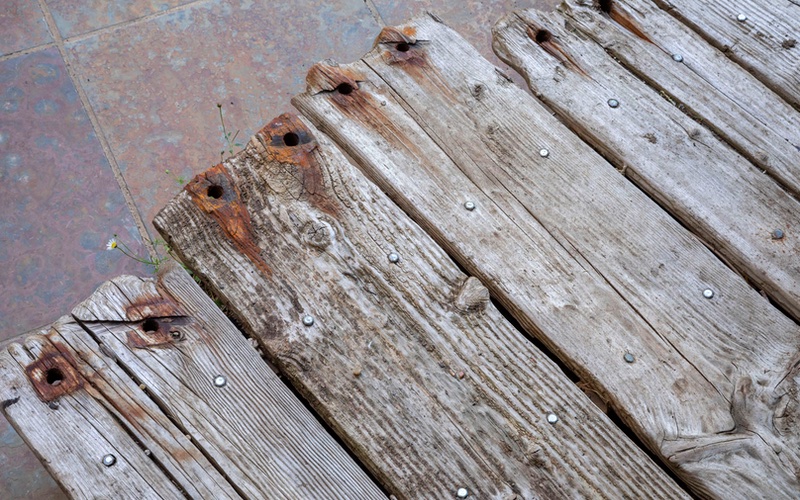
Reclaimed Douglas Fir decking, one of the many recycled and reclaimed materials used throughout the garden.
What is the ethos of the sustainable aesthetic and why is it important? The sustainable garden weathers well in the British climate, blends in with its surroundings, accommodates and encourages interaction with wildlife and does not damage the environment in its creation. It follows a number of principles;
Protect and nurture the holy trinity of soil, plants and insects. Do this and good things will follow. In ‘The Urban Retreat’ all soil was kept on site.
Reduce waste. In this garden all existing pots and planters were recycled along with the brick work. Paving sub-base materials were re-used where appropriate or sent for off-site recycling with any green waste produced. Energetic waste can also be reduced by designing closed systems and features that have multiple benefits. For example, planting Comfrey for its aesthetic appeal, ability to attract and feed insects, provision of composting material and medicinal applications.
We can further reduce waste by working with the existing lay of the land, soil type, microclimate, ‘hard’ and ‘soft’ vernacular, moisture levels, ‘habitat’ type, etc. The existing garden had a woodland edge feel and Jilayne used this to inform her plant choices. Woodland edge gardens are cooling and relaxing in the heat of a city summer.
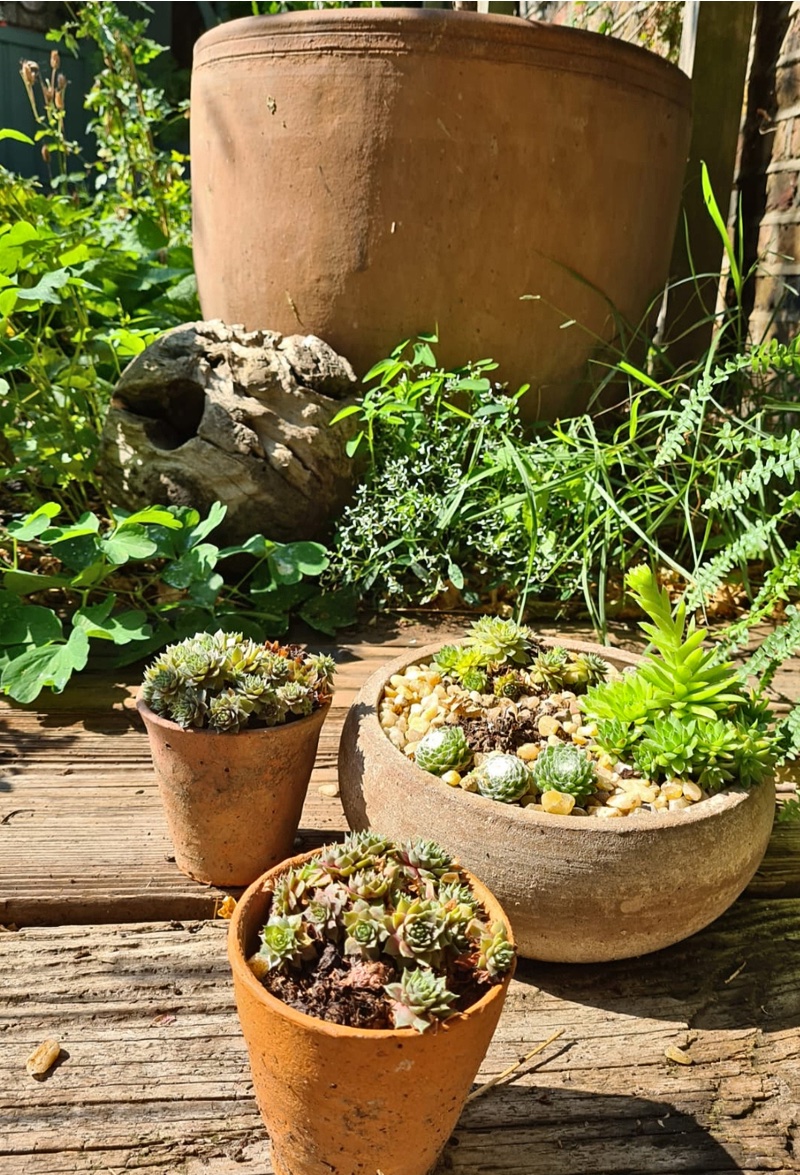
Existing pots and planters were recycled and wildlife friendly planting was retained.
Useful, wildlife friendly planting was retained and any unwanted plants were donated to other gardeners. A mature Elder was a prominent existing feature. What plant can better connect us to the environment and other lifeforms? In winter it looks a wreck and we wonder will it manage to limp on through to spring? But what a change once the sap starts to rise. The leaves come on early, connecting us to the cycle of re-birth out of decay. The summer flowers are an insect magnet and can be made in to refreshing drinks. The autumn berries feed birds and small mammals whilst boosting our immune systems through winter when processed in to medicinal food and drink. Dried out Elder canes are also the best material for the hand drill-one of the first ways our ancestors kindled fire. Try it yourself to fully appreciate their achievements! Plants of this kind re-connect us with our history and birthright and, in doing so, help dispel the illusion that we are somehow ‘outside’ of nature. Through constant exposure to the damaging aspects of our existence we have grown to believe degradation is our hallmark. Gardens are the one of the arenas in which we can reassert the positive elements of human intervention and perhaps see our purpose on this planet.
Specify plants and hardscape that don’t need mollycoddling. Opt for resilient plants and stone and timber types that don’t need constant sealing or cleaning. Reclaimed materials achieve this end and also tick the sustainability box- they have not been newly created and therefore no further finite resources have been consumed. In terms of timber, we used reclaimed Douglas Fir decking and shelving and reclaimed Oak for the seating block/retaining wall in this garden. Reclaimed slate and granite was used for the paving. Jilayne and the client went shopping in local markets for the second hand furniture, fixtures and fittings. All the reclaimed materials were of British provenance. When reclaimed wood cannot be used specify locally sourced FSC-certified timber from trusted suppliers.

Reclaimed timber, slate and granite were used throughout the garden as well as second hand furniture, fixtures and fittings.
Permeable surfaces allow rain water to percolate back in to the ground and to that end gravel was used extensively in this garden. More generally, look to make surfaces more porous with the aim of increasing biodiversity. Block and brick retaining walls could be replaced with gabions which allow unwanted existing materials such as paving and walling to be used as in-fill.
Sustainable gardens aim to be as ‘soft’ as possible. Planting should be diverse, successional and nectar-rich. Utilise a range of trees, shrubs, climbers, grasses and bulbs to provide food and shelter for wildlife. Don’t forget; attractiveness to humans is of equal importance if the garden is to be considered a success by the client!
Go easy on garden lighting and chemical weed and pest control. Neither were used in this scheme.
However, the garden wasn’t a perfect example of sustainability. There were a number of areas where our activities were damaging;
- Cement and adhesives were used. Both material have a high environmental impact.
- Fossil fuels were consumed and pollutants produced in travelling to and from site.
- Space restrictions dictated all deliveries were bagged. To reduce waste specify loose deliveries wherever possible.
- Gravel extraction degrades wildlife habitat.
How can we improve? At Landscaping Solutions we are committed to continual professional development through seminars, courses, workshops and personal study. Integration of environmental assessments to our CDM process helps us think about how we can reduce our impact and guides our landscape design decisions and installation techniques. This is a great tool but can only take us so far due to the fact that much of the raw information is based on intuition. There is a need to develop an industry accepted framework to help us better understand the relative impact of various materials and practices. For instance, we might assume artificial turf to be more impactful than paving but in some instances artificial turf allows the ground to ‘breath’ more than paving. Leave artificial turf to its own devices and it develops into ‘habitat’ much quicker than paving, rapidly hosting an array of plant and invertebrate life. However, can it be recycled satisfactorily? And which of these is most environmentally impactful; quarried British Yorkstone or Italian porcelain? What about quarried Indian sandstone v Italian porcelain? Or Indian sandstone v Indian porcelain. Yorkstone v Portland Stone? Portland stone from open cast extraction v undersea deposits? These are complicated questions.
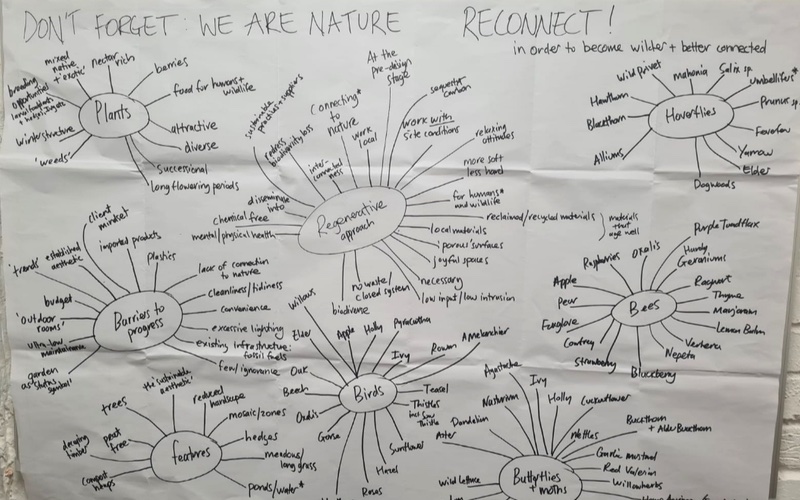
Regular brainstorming sessions helped guide our design decisions and installation techniques.
Good reliable information will enable us to compile a database of suppliers employing sustainable practices. For ‘The Urban Retreat’ we used Ashwells Timber and CED Stone.
Responsive clients might be encouraged to engage with food production be it wild or cultivated and on whatever scale possible. This takes the pressure off the industrial agricultural system, promotes personal resilience, self-sufficiency, understanding of our role in the ecosystem, empathy with other life forms and mental and physical health. Studies have shown low-input vegetable and fruit allotments to be the most biodiverse land use in the country. They can be further improved by providing a body of water and adding on-site composting facilities.
One last piece of advice; don’t forget to have fun!
CONSTRUCTION DESIGN AND MANAGEMENT – HELP FOR GARDEN DESIGNERS
CDM - Construction Design Management - is something we’ve noticed makes a lot of garden designers nervous. Brought in in 2007 and revised in 2015, the Construction (Design and Management) Regulations demand that every project has suitably qualified and experienced duty holders in place, to shoulder the designated responsibilities and, in the case of designers, this consists of “identifying, eliminating or controlling foreseeable risks”.
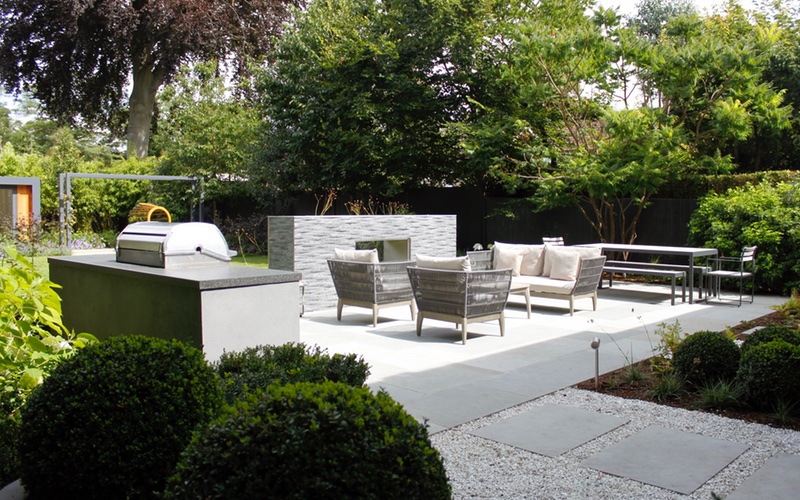
A finished project for a garden near Richmond.
The regs also demand that designers prepare and provide relevant information to those who need it and liaise with the principal contractor “to help in the planning, management, monitoring and coordination of the construction phase”.
Put like that, it’s understandable that, as the regulations finally begin to filter into the landscaping industry, there are a few qualms. Funnily enough, it’s the domestic sector that’s feeling the burden most, rather than contractors working on the commercial side; when you’re working for the likes of Taylor Wimpey you’ll be a very big fish to be principal anything.
Working for home-owners is different. They, too, have their responsibilities, but aren’t expected to understand them. Former BALI chairman Richard Gardiner runs Nag Solutions, which helps landscape companies improve their compliance credentials, and sums up the situation this way. “The problems come in the domestic sector. There’s no pressure from the client, the home-owner, and you wouldn’t expect them to be up to speed. It’s more challenging than the commercial sector because most of the time the domestic contractor operates as principal contractor, and a lot of responsibility sits with the principal contractor. Contractors do tend to bury their heads a bit.”

Machinery should be placed in a safe position.
It’s the same with designers. “Again, they bury their heads,” he says. “The designer is the interface with the client. If they are aware of what they should be doing, then they should guide the client.”
At Landscaping Solutions, our heads are well and truly above ground. Some time ago, we took a good hard look at what is demanded and how far we fulfilled it, and we brought Richard in as the expert to check us over for any gaps in our approach. Consequently, we’ve embraced CDM with quite a bit of enthusiasm.
Why? Ben West, owner of Landscaping Solutions explains, “It’s going to increase professionalism and bring the landscaping industry in line with the rest of the construction industry, which is quite far ahead of us in this area. It’ll reduce accidents by making the consideration of risks and hazards part of the design process, so that, hopefully, they’re designed out of forthcoming schemes. And it’s going to make the finished garden a safer place for the homeowner and their visitors.”
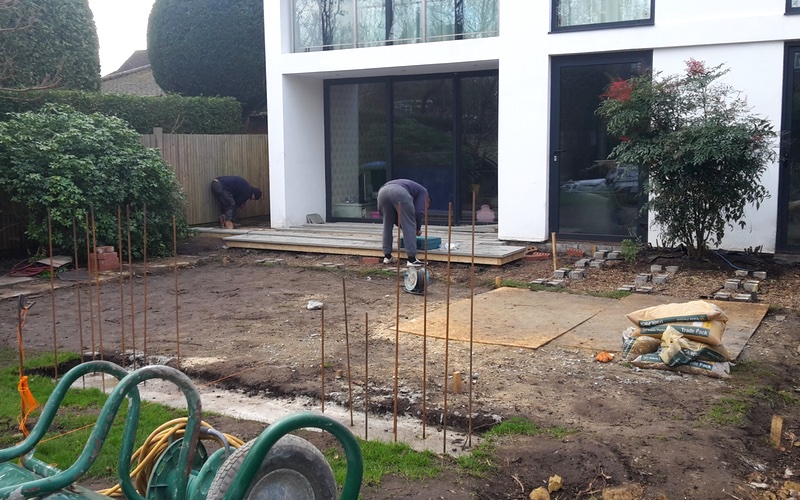
A tidy site is a safer site.
What this means for you, as a designer, is that we know what’s needed and can help you with your responsibilities. “We recently did a job for a lady who wasn’t sure what CDM meant,” says Ben. “We provided her with documentation, the people she could speak to, links with various websites, and looked at her current documentation to see if it was rigorous enough.”
If you’re a home-owner reading this, then you can rest easy that we understand our duties and carry them out. It will also potentially reduce your costs by flagging up potentially massive additions to the bill brought about by, for example, the use of oversized, heavy paving that will need cutting on site in hard-to-access gardens where the only solution is to bring in a crane and then cut by hand.
When you’re not used to doing something, and there are plenty of other things taking up valuable time, then getting to grips with CDM is daunting. But it doesn’t have to be.
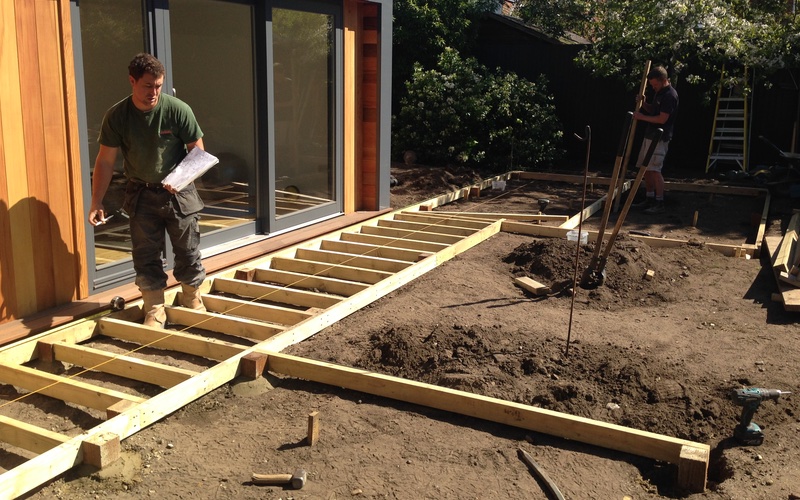
Landscapers should have all the appropriate work equipment and footwear for the job.
Paramount in CDM is the need to communicate. “Essentially, the designer should do a risk assessment for their design and talk to the contractor,” says Richard Gardiner. “The contractor might come up with a different way to solve a problem which is more satisfactory. All parties need to be in communication, putting the client, designer and contractor in tune with each other.”
If you’ve read our post on The Secret to a Bali Award-Winning Garden, then you’ll know that communication is one of our priorities. That project demanded hundreds of both emails and phone calls. If a problem occurs, we’ll let you know. If a schedule needs to be rejigged because of a delayed delivery, we’ll tell you. If we foresee a pitfall in the way things are scheduled, we’ll suggest a solution.
CDM doesn’t have to be feared. It’s raising standards across the industry and that has to be applauded. However, everyone can do with a bit of support, especially when something’s new and full of legal implications.
“CDM is a good thing,” says Ben. “With any of our projects, we’ll be happy to offer advice to designers who are a bit unsure, and it’s a chance for everyone in the industry - landscapers and designers - to show clients and designers that we take our responsibilities seriously and recognise our duty of care to fellow contractors and our clients.”
If you’d like to discuss how we can help with the CDM requirements of your next project, give us a ring on 0208 2412402 or email us at info@landscapingsolutionsltd.co.uk
Richard Gardiner can be contacted at Nag Solutions.